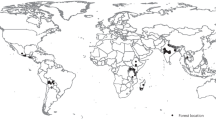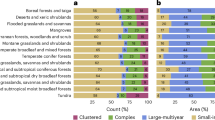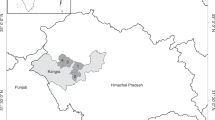Abstract
Forests have re-taken centre stage in global conversations about sustainability, climate and biodiversity. Here, we use a horizon scanning approach to identify five large-scale trends that are likely to have substantial medium- and long-term effects on forests and forest livelihoods: forest megadisturbances; changing rural demographics; the rise of the middle-class in low- and middle-income countries; increased availability, access and use of digital technologies; and large-scale infrastructure development. These trends represent human and environmental processes that are exceptionally large in geographical extent and magnitude, and difficult to reverse. They are creating new agricultural and urban frontiers, changing existing rural landscapes and practices, opening spaces for novel conservation priorities and facilitating an unprecedented development of monitoring and evaluation platforms that can be used by local communities, civil society organizations, governments and international donors. Understanding these larger-scale dynamics is key to support not only the critical role of forests in meeting livelihood aspirations locally, but also a range of other sustainability challenges more globally. We argue that a better understanding of these trends and the identification of levers for change requires that the research community not only continue to build on case studies that have dominated research efforts so far, but place a greater emphasis on causality and causal mechanisms, and generate a deeper understanding of how local, national and international geographical scales interact.
This is a preview of subscription content, access via your institution
Access options
Access Nature and 54 other Nature Portfolio journals
Get Nature+, our best-value online-access subscription
$32.99 / 30 days
cancel any time
Subscribe to this journal
Receive 12 digital issues and online access to articles
$119.00 per year
only $9.92 per issue
Buy this article
- Purchase on SpringerLink
- Instant access to full article PDF
Prices may be subject to local taxes which are calculated during checkout



Similar content being viewed by others
References
Timko, J. et al. A policy nexus approach to forests and the SDGs: tradeoffs and synergies. Curr. Opin. Env. Sust. 34, 7–12 (2018).
Katila, P. et al. Sustainable Development Goals: Their Impacts on Forests and People (Cambridge Univ. Press, 2019).
Grassi, G. et al. The key role of forests in meeting climate targets requires science for credible mitigation. Nat. Clim. Change 7, 220–226 (2017).
Butchart, S. H. M. et al. Shortfalls and solutions for meeting national and global conservation area targets. Con. Lett. 8, 329–337 (2015).
Zero Draft of the of post-2020 Global Biodiversity Framework (Convention on Biological Diversity, 2020).
Suding, K. et al. Committing to ecological restoration. Science 348, 683–640 (2015).
Bastin, J. F. et al. The global tree restoration potential. Science 365, 76–79 (2019).
IPCC Special Report on Climate Change and Land (eds Shukla, P. R. et al.) (2019).
Miller, D. C. & Hajjar, R. Forests as pathways to prosperity: empirical insights and conceptual advances. World Development (in the press).
Liu, J. et al. Systems integration for global sustainability. Science 347, 1258832 (2015).
Lenzen, M. et al. International trade drives biodiversity threats in developing nations. Nature 486, 109–112 (2012).
Sheldon, T. & Sankaran, C. The impact of Indonesian forest fires on Singaporean pollution and health. Am. Econ. Rev. 107, 526–529 (2017).
Sutherland, W. J., Fleishman, E., Mascia, M. B., Pretty, P. & Rudd, M. A. Methods for collaboratively identifying research priorities and emerging issues in science and policy. Methods Ecol. Evol. 2, 238–247 (2011).
Cabinet Office. Horizon Scanning Programme: a New Approach for Policy Making (UK Government Office for Science, 2013).
Sutherland, W. J. et al. Ten years on. A review of the first global conservation horizon scan. Trends Ecol. Evol. 34, 139–153 (2019).
Bengston, D. N. Horizon Scanning for Environmental Foresight: a Review of Issues and Approaches Report No. GTR-NRS-121 (U. S. D. A. Forest Service, 2013).
Statement on the Status of the Global Climate in 2018 (World Meteorological Organization, 2018).
Millar, C. I. & Stephenson, N. L. Temperate forest health in an era of emerging megadisturbance. Science 349, 823–826 (2015).
Hubbart, J. A., Guyette, R. & Muzika, R. M. More than drought: precipitation variance, excessive wetness, pathogens and the future of the western edge of the eastern deciduous forest. Sci. Total Environ. 566, 463–467 (2016).
Brienen, R. J. W. et al. Long-term decline of the Amazon carbon sink. Nature 519, 334–348 (2015).
Lawrence, D. & Vandecar, K. Effects of tropical deforestation on climate and agriculture. Nat. Clim. Change 5, 27–36 (2015).
IPBES. Summary for Policymakers. In The Global Assessment Report on Biodiversity and Ecosystem Services of the Intergovernmental Science-Policy Platform on Biodiversity and Ecosystem Services (IPBES secretariat, 2019).
Smith, A. M. S. et al. The science of firescapes: achieving fire-resilient communities. BioScience 66, 130–146 (2016).
Olivero, J. et al. Recent loss of closed forests is associated with Ebola virus disease outbreaks. Sci. Rep. 7, 142971 (2017).
De Pinto, A. et al. The role of crop production in the forest landscape restoration approach – assessing potential benefits of meeting the Bonn Challenge. Front. Sustain. Food Syst. 4, 61 (2020).
Hecht, S. et al. People in motion, forests in transition: trends in migration, urbanization, and remittances and their effects on tropical forests (Center for International Forestry Research (CIFOR), 2015).
Knight, J. & Gunatilaka, R. Great expectations? The subjective well-being of rural-urban migrants in China. World Dev. 38, 113–124 (2010).
Oldekop, J. A., Sims, K. R. E., Whittingham, M. J. & Agrawal, A. An upside to globalization: International migration drives reforestation in Nepal. Glob. Environ. Chang. 52, 66–74 (2018).
Robson, J. & Berkes, F. How does out-migration affect community institutions. A study of two indigenous municipalities in Oaxaca, Mexico. Hum. Ecol. 39, 179–190 (2011).
Montefrio, M. J. F., Ortiga, Y. Y. & Josol, M. R. C. B. Inducing development: social remittances and the expansion of oil palm. Int. Migr. Rev. 48, 216–242 (2014).
Van Hear, N., Bakewell, O. & Long, K. Push-pulls plus: reconsidering drivers of migration. J. Ethn. Migr. Stud. 44, 927–944 (2018).
Fischer, J. et al. Land sparing versus land sharing: moving forward. Conserv. Lett. 7, 149–157 (2014).
Davis K. F. et al. Tropical forest loss enhanced by large-scale land acquisitions. Nat. Geosci. (in the press).
Pezzini, M. An emerging middle class. OECD Observer http://oecdobserver.org/news/fullstory.php/aid/3681/An_emerging_middle_class.html (2012).
Alexander, P. et al. Drivers for global agricultural land use change: the nexus of diet, population, yield and bioenergy. Glob. Environ. Chang. 35, 138–147 (2015).
Borras, S. M. Jr, Hall, R., Scoones, I., White, B. & Wolford, W. Towards and better understanding of global land grabbing: and editorial introduction. J. Peasant Stud. 38, 209–216 (2011).
Curtis, P. G., Slay, C. M., Harris, N. L., Tyukavina, A. & Hansen, M. C. Classifying drivers of global forest loss. Science 361, 1108–1111 (2018).
City slickers on the farm: Africa’s real land grab. The Economist https://www.economist.com/middle-east-and-africa/2016/07/21/africas-real-land-grab (2016).
Kremen, C. & Merenlender, A. M. Landscapes that work for biodiversity and people. Science 362, eaau6020 (2018).
Willet, W. et al. Food in the Anthropocene: the EAT-Lancet Commission on healthy diets from sustainable food systems. Lancet 393, 447–492 (2019).
Rowland, D., Ickowitz, A., Powell, B., Nasi, R. & Sutherland, T. Forest foods and healthy diets: quantifying the contributions. Environ. Conserv. 44, 102–114 (2017).
Digital Dividends (World Bank, 2016).
Castrén, T. & Pillai, M. Information and Communication Technology for Forest Law Enforcement and Governance (Program on Forests (PROFOR), 2015).
Wright, T. How many drones are smuggling drugs across the U. S. Southern Border? Air & Space Magazine https://www.airspacemag.com/flight-today/narcodrones-180974934/ (2020).
Gardner, T. A. et al. Transparency and sustainability in global commodity supply chains. World Dev. 121, 163–177 (2019).
Agrawal, A., Brown, D. G. & Sullivan, J. A. Are global land grabs ticking socio-environmental bombs or just inefficient investments. One Earth 1, 159–162 (2019).
le Polain de Waroux, Y. et al. The restructuring of South American soy and beef production and trade under changing environmental regulations. World Dev. 121, 188–202 (2019).
Bebbington, A. J. et al. Resource extraction and infrastructure threaten forest cover and community rights. Proc. Natl Acad. Sci. USA 115, 13164–13173 (2018).
Coenen, J. et al. Environmental governance of China’s Belt and Road Initiative. Environ. Policy Gov. (in the press).
Laurance, W. F. et al. A global strategy for road building. Nature 513, 229–232 (2014).
Lees, A. C., Peres, C. A., Fearnside, P. M., Schneider, M. & Zuanon, J. A. S. Hydropower and the future of Amazonian biodiversity. Biodivers. Conserv. 25, 451–466 (2016).
Golden Kroner, R. E. et al. The uncertain future of protected lands and waters. Science 364, 881–886 (2019).
Asner, G. P., Llactayo, W., Tupayachi, R. & Luna, E. R. Elevated rates of gold mining in the Amazon revealed through high-resolution monitoring. Proc. Natl Acad. Sci. USA 110, 18454–18459 (2013).
Bebbington, A. J. et al. Priorities for governing large-scale infrastructure in the tropics. Proc. Natl Acad. Sci. USA 117, 21829–21833 (2020).
Walker, R. & Simmons, C. Endangered Amazon: an indigenous tribe fights back against hydropower development in the Tapajós valley. Environment: Science and Policy For Sustainable Development 60, 4–15 (2018).
Kolstad, I. & Søreide, T. Corruption in natural resource management: implications for policy makers. Resour. Policy 34, 214–226 (2009).
Cheng, S. H. et al. A systematic map of evidence on the contribution of forests to poverty alleviation. Environ. Evid. 8, 3 (2019).
Oldekop, J. A. et al. Reductions in poverty and deforestation from decentralized forest management in Nepal. Nat. Sustain. 2, 421–428 (2019).
Ferraro, P. J., Hanauer, M. M. & Sims, K. R. E. Conditions associated with protected area success in conservation and poverty reduction. Proc. Natl Acad. Sci. USA 108, 13913–13918 (2011).
Ferraro, P. J., Sanchirico, J. N. & Smith, M. D. Causal inference in coupled human and natural systems. Proc. Natl Acad. Sci. USA 116, 5311–5318 (2019).
Miller, D. C., Mansourian, S. & Wildburger, C. (eds) Forests, Trees and the Eradication of Poverty: Potential and Limitations. A Global Assessment Report Vol. 39 (IUFRO World Series, 2020).
Sloan, S. The development-driven forest transition and its utility for REDD. Ecol. Econ. 116, 1–11 (2015).
Gelman, A. & Imbens, A. Why ask why? Forward causal inference and reverse causal questions. National Bureau of Economic Research Working Paper 19614 (National Bureau of Economic Research, 2013).
Noyes, J. et al. In Cochrane Handbook for Systematic Reviews of Interventions (eds Higgins, J. P. T. et al.) 525–545 (Wiley & Sons, Ltd., 2019).
Rana, P. & Miller, D. C. Machine learning to analyze the social-ecological impacts of natural resource policy: insights from community forest management in the Indian Himalaya. Environ. Res. Lett. 14, 024008 (2019).
Ferraro, P. J. et al. Estimating the impacts of conservation on ecosystem services and poverty by integrating modeling and evaluation. Proc. Natl Acad. Sci. USA 112, 7420–7425 (2015).
Jayachandran, S. et al. Cash for carbon: a randomized trial of payment for ecosystem services to reduce deforestation. Science 357, 267–273 (2017).
World Bank Microdata Library. World Bank https://microdata.worldbank.org/index.php/home (2020).
Shepherd, G., Kazoora, C. & Mueller, D. Forest Livelihoods and Poverty Alleviation: The Case of Uganda. Forestry Policy and Institutions Working Paper 32 (FAO, 2013).
Jean, N. et al. Combining satellite imagery and machine learning to predict poverty. Science 353, 790–794 (2016).
Butt, N., Lambrick, F., Menton, M. & Renwick, A. The supply chain of violence. Nat. Sustain. 2, 742–747 (2019).
Toumbourou, T., Muhdar, M., Werner, T. & Bebbington, A. J. Political ecologies of the post-mining landscape: activism, resistance, and legal struggles over Kalimantan’s coal mines. Energy Res. Soc. Sci. 65, 101476 (2020).
World Bank Open Data. World Bank https://data.worldbank.org (2019).
Africa in 50 Year’s Time (African Development Bank, 2011).
Acknowledgements
This work was funded by the UK’s Department for International Development (grant no. 203516-102) and governed by the University of Michigan’s Institutional Review Board (HUM00092191). J.A.O. acknowledges the support of a European Union FP7 Marie Curie international outgoing fellowship (FORCONEPAL). L.V.R. was funded by the European Research Council (ERC) under the European Union’s Horizon 2020 Research and Innovation Programme (grant agreement no. 853222 FORESTDIET). A.J.B. acknowledges the support of an Australian Research Council Australia Laureate Fellowship (grant no. FL160100072). L.B.F. acknowledges support from the European Union Marie Curie global fellowship (CONRICONF). P.M. was supported by the European Research Council (ERC) under the European Union’s Horizon 2020 research and innovation program (grant agreement no. 677140 MIDLAND). R.N. was supported by the CGIAR Research Programme on Forests, Trees and Agroforestry. This Perspective contributes to the Global Land Programme (https://glp.earth).
Author information
Authors and Affiliations
Contributions
J.A.O., L.V.R., A.A., C.W. and S.J.W. designed the horizon scan and convened the panel. J.A.O., L.V.R., A.A., A.J.B., P.M., D.N.B., A.B., S.B., I.D.H., P.D., S.C.D., L.B.F., T.G., C.K., K.K., D.M., T.H.M., R.N., M.N., M.A.P.V., J.M.R., W.J.S., C.W. and S.J.W. took part in the horizon scan. J.A.O. and L.V.R. drafted the initial manuscript with input from A.A., A.J.B. and P.M., which was then finalized by D.N.B., A.B., S.B., I.D.H., P.D., S.C.D., L.B.F., T.G., C.K., K.K., D.M., T.H.M., R.N., M.N., M.A.P.V., J.M.R., W.J.S., C.W. and S.J.W.
Corresponding author
Ethics declarations
Competing interests
The authors declare no competing interests.
Additional information
Peer review information Nature Plants thanks Robert Kozak and Pamela McElwee for their contribution to the peer review of this work.
Publisher’s note Springer Nature remains neutral with regard to jurisdictional claims in published maps and institutional affiliations.
Rights and permissions
About this article
Cite this article
Oldekop, J.A., Rasmussen, L.V., Agrawal, A. et al. Forest-linked livelihoods in a globalized world. Nat. Plants 6, 1400–1407 (2020). https://doi.org/10.1038/s41477-020-00814-9
Received:
Accepted:
Published:
Issue date:
DOI: https://doi.org/10.1038/s41477-020-00814-9
This article is cited by
-
A 45-year global analysis of the spatial human forest nexus
Communications Earth & Environment (2025)
-
Estimating forest biophysical and biochemical parameters in Behali Reserve Forest (Assam) using proximal and remote sensing techniques
Tropical Ecology (2025)
-
Evaluation of Resource Dependency and Conservation Attitude among the Local Populations in Select Forest Regions and Protected Areas for Management Planning in the Kashmir Himalaya
Human Ecology (2025)
-
Local community perceptions on ecosystem services utilisation—implications for sustainable management of Kakamega Forest in Kenya
Agroforestry Systems (2025)
-
The costs of subsidies and externalities of economic activities driving nature decline
Ambio (2025)



